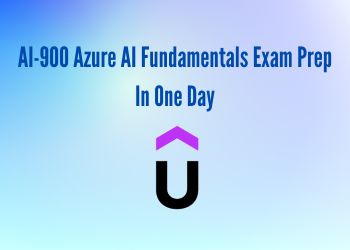Welcome to the Microsoft AI-900 Azure AI Fundamentals certification exam, which will open your eyes to the intriguing fields of Artificial Intelligence and Machine Learning that are supported by the flexible Microsoft Azure services. With this exam, you can demonstrate your understanding of AI and ML ideas and how they integrate with the Azure platform.
You will start on a transforming journey as a candidate for this certification that cuts across both technical and non-technical backgrounds. This test welcomes everybody, making it accessible and interesting for everyone, regardless of your past data science and software engineering skills or where you are in your AI journey.
Microsoft AI-900 Certification Exam Questions and Answers
Goal of AI-900 Certification Exam: The goal of AI-900 is to equip you with the fundamentals of machine learning on Azure, allowing you to access a wide range of AI applications and concerns. You will delve into the fascinating field of computer vision as you gain knowledge about how AI can see and comprehend our surroundings. You will also explore the fascinating field of Natural Language Processing (NLP), where you will see how AI can comprehend and engage with human language.
Although prior knowledge of client-server apps and cloud fundamentals may be helpful, it is not a must. You may use Azure AI Fundamentals as a stepping stone to additional Azure role-based certifications like Azure Data Scientist Associate or Azure AI Engineer Associate since it welcomes students from different backgrounds.
What You’ll Learn: You will learn how AI is reshaping industries, improving daily experiences, and revolutionizing how we interact with technology as you set out on this momentous adventure. Your certification journey doesn’t end here; rather, it serves as a stepping stone to an AI-powered future where your knowledge will be essential in determining how the world will be in the future.
So, are you prepared to go into the world of artificial intelligence and machine learning with the might of Microsoft Azure? Together, let’s start this fascinating journey, and with the Microsoft AI-900 Azure AI Fundamentals certification, you may attain your full potential as an AI pioneer.
Microsoft AI-900 Certification Exam Questions and Answers
Beginner level:
Q1. Which of the following scenarios best represents an AI workload?
- A) Analyzing sales data to identify trends and patterns.
- B) Running a web server to host a website.
- C) Backing up files to a cloud storage service.
- D) Sending emails to customers.
Correct Answer: A
Check out the Solution:
Analyzing sales data to identify trends and patterns represents an AI workload, where machine learning techniques can be applied to gain insights from data and make predictions.
Q2. What is the primary goal of supervised machine learning?
- A) To learn patterns and relationships from data without labeled examples.
- B) To classify data into predefined categories.
- C) To identify anomalies and outliers in data.
- D) To perform data analysis using unsupervised algorithms.
Correct Answer: B
Check out the Solution:
The primary goal of supervised machine learning is to classify data into predefined categories based on labeled examples, where the model is trained using a dataset with known outcomes.
Q3. Which of the following AI scenarios is an example of computer vision?
- A) Recognizing speech in audio recordings.
- B) Identifying objects in images.
- C) Analyzing customer sentiments from social media posts.
- D) Recommending products to online shoppers.
Correct Answer: B
Check out the Solution:
Identifying objects in images represents a computer vision workload, where AI models can be used to detect and recognize objects, faces, or patterns in images.
Q4. What is the primary application of sentiment analysis in Natural Language Processing (NLP)?
- A) Identifying the subject of a text.
- B) Summarizing long paragraphs into concise sentences.
- C) Analyzing emotions and opinions in text data.
- D) Converting text into speech.
Correct Answer: C
Check out the Solution:
The primary application of sentiment analysis in NLP is to analyze emotions and opinions expressed in text data, determining whether the sentiment is positive, negative, or neutral.
Q5. Which type of AI workload involves training a model to predict future outcomes based on historical data?
- A) Computer Vision Workload
- B) Natural Language Processing (NLP) Workload
- C) Predictive Analytics Workload
- D) Speech Recognition Workload
Correct Answer: C
Check out the Solution:
Predictive Analytics Workload involves training AI models to predict future outcomes or behaviors based on historical data patterns and trends.
Intermediate Level:
Q1. What is the purpose of feature engineering in the machine learning process?
- A) To fine-tune the hyperparameters of a machine learning model.
- B) To extract and select relevant features from raw data to improve model performance.
- C) To visualize the distribution of data for exploratory analysis.
- D) To perform model evaluation and measure its accuracy.
Correct Answer: B
Check out the Solution:
Feature engineering involves extracting and selecting relevant features from raw data to improve the performance and effectiveness of a machine learning model.
Q2. Which AI workload is used to analyze and process natural language text data?
- A) Speech Recognition Workload
- B) Predictive Analytics Workload
- C) Natural Language Processing (NLP) Workload
- D) Computer Vision Workload
Correct Answer: C
Check out the Solution:
Natural Language Processing (NLP) Workload is used to analyze and process natural language text data, including tasks like sentiment analysis, language translation, and entity recognition.
Q3. Which technique is commonly used in computer vision to classify objects in an image?
- A) Clustering
- B) Regression
- C) Convolutional Neural Networks (CNN)
- D) Decision Trees
Correct Answer: C
Check out the Solution:
Convolutional Neural Networks (CNN) are commonly used in computer vision to classify objects in an image, as they can automatically learn and recognize patterns and features.
Q4. What is the primary goal of named entity recognition (NER) in NLP?
- A) Extracting key features from text data.
- B) Analyzing the sentiment of a sentence.
- C) Identifying and categorizing entities in text, such as names, dates, and locations.
- D) Summarizing a large document into a short paragraph.
Correct Answer: C
Check out the Solution:
The primary goal of named entity recognition (NER) in NLP is to identify and categorize entities in text, such as names of people, dates, locations, and other specific entities.
Q5. Which Azure service is commonly used for building and training machine learning models?
- A) Azure Logic Apps
- B) Azure Kubernetes Service (AKS)
- C) Azure Machine Learning
- D) Azure Stream Analytics
Correct Answer: C
Check out the Soultion:
Azure Machine Learning is commonly used for building, training, and deploying machine learning models on Azure. It provides a scalable and integrated environment for the end-to-end machine learning workflow.
Advance level:
Q1. Explain the importance of data privacy and ethics in AI workloads.
- A) Data privacy and ethics are essential considerations in AI workloads to ensure that data is handled responsibly, protecting individuals’ privacy and avoiding bias or discriminatory outcomes.
- B) Data privacy and ethics are only relevant for computer vision workloads, as they involve processing visual data.
- C) Data privacy and ethics are not significant concerns in AI workloads, as the focus is on achieving accurate results.
- D) Data privacy and ethics are primarily the responsibility of the AI models, not the organizations deploying them.
Correct Answer: A
Check out the Solution:
Data privacy and ethics are essential considerations in AI workloads to ensure that data is handled responsibly, protecting individuals’ privacy, and avoiding bias or discriminatory outcomes.
Q2. What are hyperparameters in the context of machine learning models?
- A) Hyperparameters are the model’s parameters that are learned from the training data.
- B) Hyperparameters are the input features used to train the model.
- C) Hyperparameters are the weights and biases of a neural network.
- D) Hyperparameters are the settings or configurations that control the learning process, such as learning rate and number of layers.
Correct Answer: D
Check out the Solution:
Hyperparameters are the settings or configurations that control the learning process of a machine learning model. Examples include learning rate, the number of hidden layers in a neural network, and the number of iterations during training.
Q3. Which AI workload is best suited for detecting credit card fraud?
- A) Predictive Analytics Workload
- B) Speech Recognition Workload
- C) Computer Vision Workload
- D) Anomaly Detection Workload
Correct Answer: D
Check out the Solution:
Anomaly Detection Workload is best suited for detecting credit card fraud, as it can identify unusual patterns or outliers in data, which may indicate fraudulent activities.
Q4. What is the purpose of object detection in computer vision?
- A) To classify images into predefined categories.
- B) To detect and recognize objects or patterns within an image.
- C) To generate new images from existing datasets.
- D) To convert images into speech.
Correct Answer: B
Check out the Solution:
The purpose of object detection in computer vision is to detect and recognize objects or patterns within an image, allowing AI models to identify multiple objects and their locations.
Q5. Which NLP technique is commonly used for language translation tasks?
- A) Sentiment Analysis
- B) Named Entity Recognition (NER)
- C) Text Summarization
- D) Machine Translation
Correct Answer: D
Check out the Solution:
Machine Translation is a common NLP technique used for language translation tasks, where AI models are trained to translate text from one language to another.
Q6. Explain the concept of explainable AI and its importance in AI workloads.
- A) Explainable AI refers to AI models that can interpret and explain their decision-making process, making it easier for humans to understand and trust the model’s outcomes. It is important to ensure transparency and accountability in AI applications.
- B) Explainable AI is a technique used to enhance the accuracy of AI models by providing additional data for training.
- C) Explainable AI is not relevant for computer vision workloads, as they deal with visual data.
- D) Explainable AI is a marketing term used for AI models with advanced capabilities.
Correct Answer: A
Check out the Solution:
Explainable AI refers to AI models that can interpret and explain their decision-making process, providing insights into why a certain prediction or decision was made. It is essential to ensure transparency, accountability, and user trust in AI applications.
Some Best Microsoft AI-900 Training Courses with Certification:
 AI-900 Azure AI Fundamentals Exam Prep In One Day
AI-900 Azure AI Fundamentals Exam Prep In One Day- Scott Duffy via Udemy
- 18,692+ already enrolled!
- ★★★★☆ (3,803 Ratings)
 AI-900: Microsoft Azure AI Fundamentals Practice Tests, 2023
AI-900: Microsoft Azure AI Fundamentals Practice Tests, 2023- Aman Goswami via Udemy
- 867+ already enrolled!
- ★★★★★ (171 Ratings)
 AI-900: Microsoft Azure AI Fundamentals in a Weekend
AI-900: Microsoft Azure AI Fundamentals in a Weekend
- Ranga Karanam via Udemy
- 11,031+ already enrolled!
- ★★★★★ (2,209 ratings)


